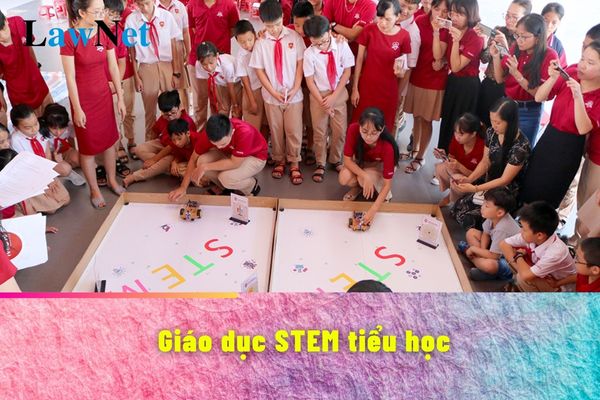3 Objectives and Requirements of STEM Education Activities in Primary Education in Vietnam
What is Primary School STEM Education in Vietnam?
Based on sub-section 1 Section 2 Official Dispatch 909/BGDDT-GDTH year 2023, the provisions on STEM education are as follows:
STEM Education Content
STEM Education is an educational approach mainly based on integrated instruction, creating opportunities for students to mobilize, aggregate knowledge, and skills in the fields of Science, Technology, Engineering, and Mathematics to develop qualities, competencies, and effectively solve real-life problems.
When implementing STEM education, it is encouraged to integrate elements of arts and humanities in some subjects/educational activities within the program to expand and enhance the effectiveness of practical education, cooperation in various ways to promote creativity, aesthetics, curiosity, and empathy in students (implementing STEAM education).
According to the stated regulation, STEM education in general or primary school STEM education, in particular, is an educational method mainly based on integrated instruction, creating opportunities for students to mobilize, aggregate knowledge, skills in the following fields, which are also the abbreviations of STEM education as follows:
- Science,
- Technology,
- Engineering,
- Mathematics.
Thus, primary school STEM education is the STEM education program at the primary school level.

3 Objectives and Requirements of STEM Education Activities in Primary Education in Vietnam (Image from Internet)
3 Objectives and Requirements of STEM Education Activities in Primary Education in Vietnam
According to Section 1 of Official Dispatch 909/BGDDT-GDTH year 2023, primary school STEM education must adhere to the following purposes:
- Raising awareness for management staff and teachers about the position, role, and significance of STEM education in implementing the Primary Education Curriculum; aligning content, methods, and organizational forms of STEM educational activities; enhancing the capacity to manage and organize STEM educational activities for teachers in primary education institutions.
- Effectively implementing STEM educational activities to support and enhance education in Science, Technology, Engineering, Mathematics, Informatics, and Arts; creating excitement and passion for learning, helping students discover their potential, explore science and technology, promote positive creativity, and apply it to solving problems in the specific context of real life.
- Organizing STEM educational activities closely aligned with the goals and requirements of subjects/educational activities, appropriate to the psychological characteristics, cognitive development level of students, and the conditions of the school; promoting integrated teaching, without creating pressure or overload for students and teachers.
What are regulations on organization of primary school STEM education in Vietnam?
Based on sub-section 2 Section 2 Official Dispatch 909/BGDDT-GDTH year 2023, the forms of organizing STEM education in primary schools are clearly stated as follows:
STEM Lessons
- Teaching subjects through STEM lessons is a form of integrated or cross-subject instruction. This is the main form of implementing STEM education in schools to effectively carry out the Primary Education Curriculum.
- The content and requirements of STEM lessons closely align with the objectives of subjects/educational activities in the Primary Education Curriculum.
- The duration of STEM lessons is scientifically and flexibly built based on the duration of related subjects/educational activities, suitable for the psychological age of students, not causing overload for them and teachers, and is reflected in the school's education plan as per regulations.
- The implementation process of STEM lessons is based on the engineering design process or scientific exploration process with appropriate learning activities for students and the use of primary school teaching equipment as prescribed by the Ministry of Education and Training, along with students' learning tools in subjects/educational activities, readily available materials for teachers and students.
- It is encouraged to use digital resources, virtual experiments, simulations, software, easily accessible in and out of the classroom to help students study autonomously.
- Student assessment in STEM lessons is conducted as prescribed for testing and assessment according to the Primary Education Curriculum.
- Based on the requirements of STEM lessons, teachers will assess students using methods such as observation, oral questioning, assessment through learning portfolios, and student products and activities.
- When assessing, it is important to emphasize process (continuous) assessment to encourage students' progress, create confidence, and enthusiasm for learning.
STEM Experiential Activities
- STEM experiential activities are a form of organizing STEM educational activities through STEM clubs, STEM fairs, STEM learning projects, or STEM experiential activities at appropriate locations according to the objectives, interests, talents, and aspirations of students to create excitement and learning motivation, contributing to developing skills, qualities, and nurturing passion and talent in students.
- STEM experiential activities are built into the school's education plan suitable to the conditions of the educational institution and the local reality.
- STEM experiential activities are designed based on cross-subject integrated teaching, addressing various fields that require students to mobilize a comprehensive knowledge and skills set to propose solutions to real-world problems flexibly and creatively.
- The space and time for conducting STEM experiential activities can extend beyond the school (production facilities, universities, research institutes, etc.), outside of the subject/educational activity time.
Familiarization with Scientific and Technical Research
Familiarization with scientific and technical research is a form of organizing STEM educational activities for students who have talents, interests, and initial curiosity in scientific and technical research to address real-life problems.
Through the process of organizing STEM lessons and STEM experiential activities, teachers identify talented students to nurture and create favorable conditions for them to familiarize themselves with scientific and technical research.
Educational institutions organize STEM educational activities to provide students with opportunities to familiarize themselves with scientific and technical research in the form of individual or group student research projects, with guidance from one or a group of teachers or cooperating with other related social forces (such as families, production facilities, universities, research institutes, science centers, experts, artisans, scientists, etc.).
Based on the actual situation, educational institutions can organize STEM experiential activities, and scientific and technical research exchange days at the unit as a basis for selecting research projects to participate in scientific and technical research playgrounds suitable for primary school students.

